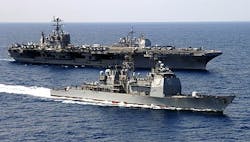Navy considers new circuit protection technologies for sensitive shipboard electronics
ARLINGTON, Va., 31 May 2013. U.S. Navy researchers are trying to find new fast-switching electrical technologies for protecting sensitive electronic circuitry aboard large surface warships in the event of malfunctions or battle damage.
The Office of Naval Research (ONR) in Arlington, Va., has issued a broad agency announcement (ONRBAA13-016 for the High Power Solid State Circuit Protection for Power Distribution and Energy Storage program, which seeks one or more electrical circuit-protection devices capable of handling high power medium voltage direct current (MVDC) aboard surface ships.
The idea is to safeguard shipboard electronics under development for new generations of advanced high power and energy weapons and sensors, such as advanced radar and high-energy laser weapons.
A key enabling technology of a ship's electrical architecture is its ability to protect circuits during a casualty while maintaining power to non-faulted loads, Navy researchers explain. To do this, experts envision future shipboard electronics with a mixture of AC, DC, and high-frequency AC energy distribution.
Circuit protection in each of these distribution systems today ranges from time-current curves of conventional circuit breakers to advanced current limiting techniques that rely on solid-state power-conversion modules.
The High Power Solid State Circuit Protection for Power Distribution and Energy Storage program is asking industry to blend several potential subsystems in new electrical circuit-protection devices that can handle high-power MVDC.
Electrical sources take a certain amount of time to produce current magnitudes that start below or at their typical continuous rated load current, and then increase to a maximum available fault current.
The problem today is that shipboard standard fault detection and clearing takes longer than the time it takes for combined electrical sources feeding the fault to reach their maximum available fault current.
For 60 Hz AC power systems, this typically happens within about four microseconds, so the Navy needs to design protective equipment able to withstand this fault current for as long it takes to detect the fault and start fault clearing. Even more time may be necessary for two or more connected circuit protective devices.
This equipment must be able to open up the fault current path physically and absorb or redirect current created in the clearing process.
Existing equipment that does this, although reliable, is relatively large, expensive, and slow, which creates large voltage disruptions when problems occur, which leaves sensitive equipment vulnerable to damage.
To compensate, ONR experts want industry to develop protective systems that can detect and clear a fault before reaching the source's maximum available fault current level, which would reduce stress on the power system and potentially shrink the size of the equipment.
The objective of the High Power Solid State Circuit Protection for Power Distribution and Energy Storage project is to develop circuit protection methods and components that allow fast switching and are compatible with the Navy's Next Generation Power System.
ONR experts say they intend to develop this technology in two phase. The first phase will run for 18 months and involve as many as four contractors. One contract will be chosen for the second three-year phase.
Companies interested should respond by 24 July 2013. For questions or concerns contact ONR's program manager, Joseph Borraccini, by phone at 703-696-7823 or by email at [email protected]. Also contact ONR's Sharon Beermann-Curtin by phone at 703-696-4321 or by email at [email protected].
More information is online at https://www.fbo.gov/spg/DON/ONR/ONR/ONRBAA13-016/listing.html.

